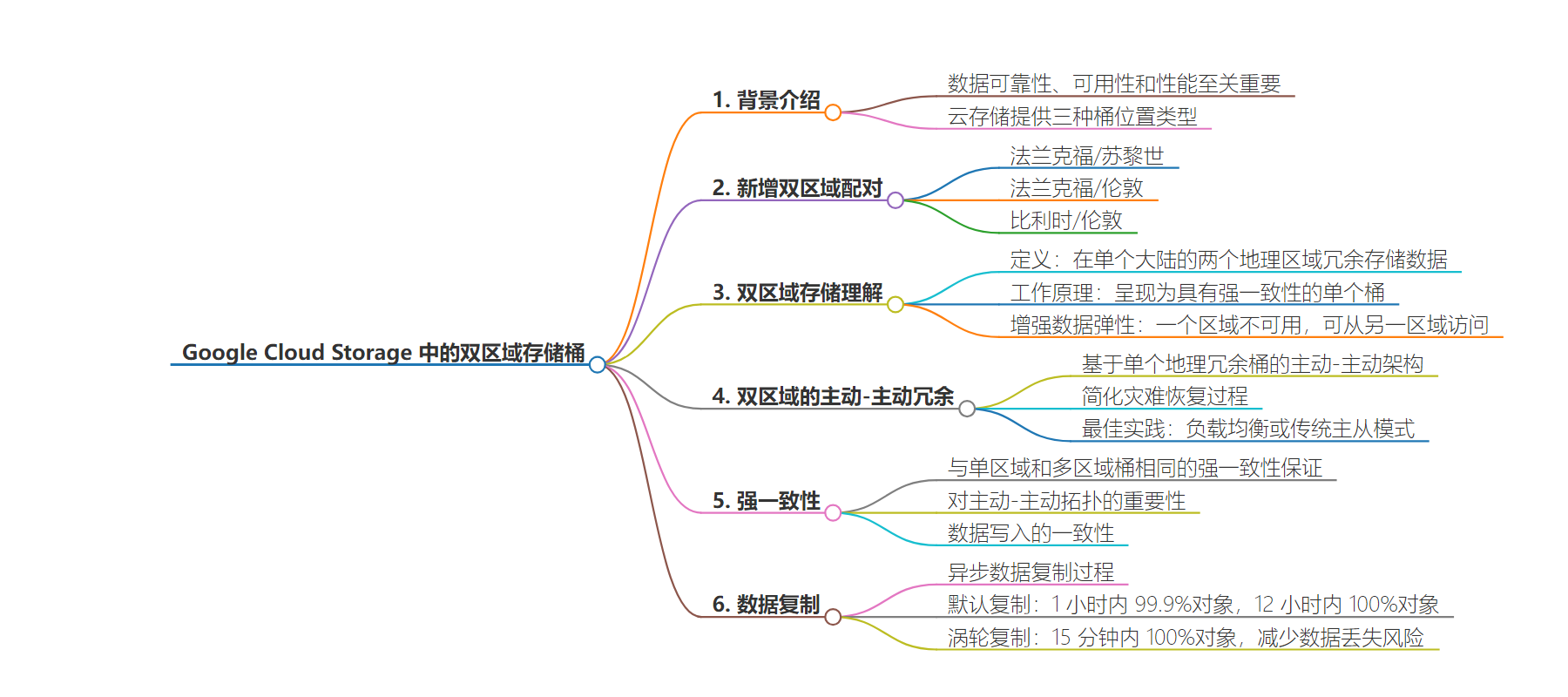包阅导读总结
1. `Google Cloud Storage`、`dual-region buckets`、`data resilience`、`strong consistency`、`replication`
2. 本文介绍了 Google Cloud Storage 中的双区域存储桶,包括其概念、工作原理、优势及新的双区域配对。强调其在数据可靠性、一致性和合规方面的作用,以及不同复制方式的特点。
3.
– 引言
– 数据可靠性、可用性和性能至关重要,Cloud Storage 提供三种桶位置类型。
– 新的双区域配对
– 新增 Frankfurt/Zurich、Frankfurt/London 和 Belgium/London 三个双区域配对,有助于欧洲数据合规。
– 理解双区域存储
– 双区域桶在同一大陆的两个不同区域冗余存储数据,呈现为单一桶,增强数据弹性。
– 双区域的主动-主动冗余
– 基于单个地理冗余桶的主动-主动架构,简化灾难恢复,可负载均衡或传统主从模式运行。
– 强一致性
– 与单区域和多区域桶有相同强一致性保证,对活跃拓扑很关键。
– 复制方式
– 默认复制:1 小时内 99.9%的新对象,12 小时内 100%的新对象实现区域冗余。
– 涡轮复制:15 分钟内 100%新对象实现区域冗余,为高级功能。
思维导图:
文章来源:cloud.google.com
作者:Subodh Bhargava
发布时间:2024/8/22 0:00
语言:英文
总字数:1083字
预计阅读时间:5分钟
评分:89分
标签:云存储,双区域存储,数据弹性,灾难恢复,Google Cloud
以下为原文内容
本内容来源于用户推荐转载,旨在分享知识与观点,如有侵权请联系删除 联系邮箱 media@ilingban.com
In today’s digital landscape, data reliability, availability, and performance are paramount. Businesses and organizations rely on cloud storage solutions that not only ensure that data is safe, but that also provide uninterrupted access and low latency. Cloud Storage is a robust solution to these challenges, offering three distinct types of bucket location types, each with their own pros and cons: single region, dual-region, and multi-region.
This is especially timely, because we continue to add Cloud Storage dual-region pairings to help businesses navigate and streamline European data compliance rules. Today, we’re excited to announce three new dual-region pairings: Frankfurt/Zurich, Frankfurt/London, and Belgium/London. By enabling data replication across geographically distinct, yet proximate locations, Cloud Storage offers data resilience and sovereignty while helping organizations adhere to stringent regulatory requirements.
Read on as we explore what dual-region storage is, how to use it effectively, and its advantages.
Understanding dual-region storage
So, what exactly is dual-region storage, and how does it work? In Cloud Storage, you need to set a geographic location for storing the object data when you create a bucket. Dual-region buckets store data redundantly across two geographically distant regions within a single continent while presenting as a single bucket (namespace) with strong consistency (more on that below). This setup enhances data resilience by ensuring that even if one entire region becomes unavailable due to a disaster or maintenance, the data remains accessible from the secondary region with no downtime. This can be especially attractive for customers who want to split their workload across the two regions as part of a business continuity / disaster recovery architecture.
Active-active redundancy across two regions
Unlike traditional storage models that take an active-passive approach, implementing “primary” and “secondary” geographic locations, Cloud Storage dual-regions use an active-active architecture based on a single geo-redundant bucket. This simplifies the disaster recovery process by eliminating the need to replicate data from one bucket to another, manually failover to a secondary bucket in the case of primary region downtime, or manually failback to the primary bucket when primary region availability is restored. In the event of a regional outage, Cloud Storage dual-region buckets continue serving all data that has been replicated across regions as required, for a recovery time objective (RTO) of zero. Temporary regional failures are normally invisible to users.
As a best practice, consider load balancing the rest of your workload across the two regions making up your dual-region bucket to take advantage of the active-active storage architecture. If you take this approach, your workload will continue to operate uninterrupted in the case of either region having an outage without the need for manual intervention. Alternatively, dual-region storage will still allow you to run the rest of your use case in a traditional primary-secondary mode across the two regions if an active-active architecture isn’t possible for whatever reason. In this case, if your primary region has an outage, you will need to fail over your compute and other resources to the secondary region where your dual-region bucket will already be available to serve your data.
Strong consistency
Dual-region buckets benefit from the same strong consistency guarantees that are available for single-region and multi-region bucket . Strong consistency is key to making the active-active topology possible—no matter when or where data is written to a dual-region bucket, you will see the most recent view of your data, without having to worry about more than one regional bucket getting out of sync with each other. Strong consistency is particularly important for ensuring that all relevant data is available for analysis to avoid inaccurate or incomplete results, for example in data analytics scenarios.
Cloud Storage dual-region buckets achieve their geo-redundancy through asynchronous data replication. During this process, newly written objects are initially protected as regional objects with redundancy across availability zones within a single region. Within a specified Recovery Point Objective (RPO) time window, the service replicates these objects to a second region, transforming them into geo-redundant objects. The duration of object replication between the two regions is determined by the bucket’s replication settings
-
Default replication provides redundancy across regions for 99.9% of newly written objects within a RPO target of one hour and 100% of newly written objects with an RPO of 12 hours. Newly written objects include uploads, rewrites, copies, and compositions. As you might expect from its name, this type of replication is the default for multi-regions and dual-regions.
-
Turbo replication is a premium feature that provides an industry-leading 15-min RPO. It is backed by the Cloud Storage Service Level Agreement (SLA) to replicate 100% of newly written objects to both regions in the dual-region within 15 minutes, regardless of object size. By providing faster redundancy across regions for data in your dual-region buckets, turbo replication reduces the risk of data loss and helps support uninterrupted service following a regional outage.
